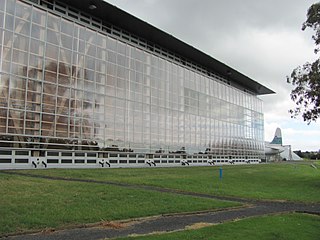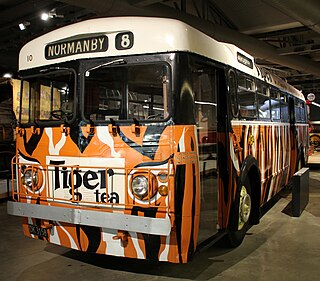
A trolleybus is an electric bus that draws power from dual overhead wires using spring-loaded trolley poles. Two wires, and two trolley poles, are required to complete the electrical circuit. This differs from a tram or streetcar, which normally uses the track as the return path, needing only one wire and one pole. They are also distinct from other kinds of electric buses, which usually rely on batteries. Power is most commonly supplied as 600-volt direct current, but there are exceptions.

The Boston-area trolleybussystem forms part of the public transportation network serving Greater Boston in the U.S. state of Massachusetts. It opened on April 11, 1936, and since 1964 has been operated by the Massachusetts Bay Transportation Authority (MBTA). It currently includes two physically isolated networks: one serving the towns of Cambridge, Belmont, and Watertown, the other – the Silver Line (Waterfront) – located in the city of Boston proper. Prior to 1964, several additional trolleybus lines were in operation in Boston proper. Measured by fleet size, the system was the third-largest trolleybus system in the United States at its peak, with only the Chicago and Atlanta systems having more trolleybuses than Boston's 463.

The Museum of Transport and Technology (MOTAT) is a science and technology museum located in Western Springs, Auckland, New Zealand. It is located close to the Western Springs Stadium, Auckland Zoo and the Western Springs Park. The museum has large collections of civilian and military aircraft and other land transport vehicles. An ongoing programme is in place to restore and conserve items in the collections. This work is largely managed by volunteers but, since the passing of the Museum of Transport and Technology Act in 2000, has been supported by full-time professional museum. New public programmes and facilities now promote the collections.
The Mexborough and Swinton Traction Company was the name adopted by the Mexborough & Swinton Tramways Company in 1929 following the introduction of trolleybuses on all its routes. It operated in the West Riding of Yorkshire, England, over routes serving Manvers Main Colliery, Wath upon Dearne and the towns of Rotherham, Rawmarsh, Swinton, Mexborough, Conisbrough and the estate at Conanby.
This list collects the transport-related vehicles exhibited or owned by the Museum of Transport and Technology (MOTAT) in Auckland, New Zealand.

Trolleybuses in Wellington were part of the Wellington public transport system from 1924 until 1932 and again from 1949 until 2017. It was the last trolleybus system operating commercially in Oceania and the last major system operating in a country where driving is on the left side of the road.

Trams in New Zealand were a major form of transport from the 19th century into the mid-20th century. New Zealand's first (horse) tramway was established in 1862 (Nelson), followed by a steam tramway in 1871 (Thames), and the first electric tramway in 1900. The tram systems in the main centres, and in some smaller towns, were soon electrified. By the 1950s, all systems were in the process of being replaced by trolley-buses or buses. The last tram service closed in 1964, in Wellington. A tram running parallel with a public road opened in Western Springs, Auckland, in 1980 and a central city loop line in Christchurch in 1995. Both are heritage lines.

The Perth trolleybus system in Western Australia, linked the capital Perth's central business district with its inner suburbs on the northern side of the Swan River. It was the first permanent trolleybus network to open in Australia, in 1933, and also the last to close, in 1969.

The Adelaide trolleybus system formed part of the public transport network in Adelaide, South Australia from 1932 until 1963.

The Teesside trolleybus system once served the conurbation of Teesside, in the North East of England. Opened on 8 November 1919, it was unusual in being a completely new system that was not replacing any previously operating tramway network.

The Walsall trolleybus system once served the town of Walsall, then in Staffordshire, but now in West Midlands, England. Opened on 22 July 1931, it gradually replaced the Walsall Corporation Tramways network.

The Vancouver trolley bus system forms part of the TransLink public transport network serving Metro Vancouver in the Canadian province of British Columbia. In operation since 1948, the system presently comprises 13 routes and is managed by the Coast Mountain Bus Company, a subsidiary of TransLink. It uses a fleet of 262 trolley buses, of which 74 are articulated vehicles.

The San Francisco trolleybus system forms part of the public transportation network serving San Francisco, in the state of California, United States. Opened on October 6, 1935, it presently comprises 15 lines, and is operated by the San Francisco Municipal Railway, commonly known as Muni, with around 300 trolleybuses. In San Francisco, these vehicles are also known as "trolley coaches", a term that was the most common name for trolleybuses in the United States in the middle decades of the 20th century.

The Dayton trolleybus system forms part of the public transportation network serving Dayton, in the state of Ohio, United States. Opened on April 23, 1933, it presently comprises seven lines, and is operated by the Greater Dayton Regional Transit Authority, with a fleet of 54 trolleybuses.

The Philadelphia trolleybus system, or trackless trolley system as it is known by its operator, forms part of the public transportation network serving Philadelphia, in the state of Pennsylvania, United States. It opened on October 14, 1923, and is now the second-longest-lived trolleybus system in the world. One of only five such systems currently operating in the U.S., it presently comprises three lines, and is operated by the Southeastern Pennsylvania Transportation Authority (SEPTA), with a fleet of 38 trolleybuses. The three surviving routes serve North and Northeast Philadelphia and connect with SEPTA's Market–Frankford rapid transit line.

The Hobart trolleybus system was part of the public transport network in Hobart, the capital city of Tasmania, Australia, for more than 30 years in the mid-twentieth century.
The Launceston trolleybus system was part of the public transport network in Launceston, Tasmania, Australia, for nearly 20 years in the mid-20th century.

The Singapore trolleybus system formed part of the transportation network of Singapore from 1926 to 1962. The system was constructed between 1926 and 1927 as a replacement to the Singapore tramway network with the old tram routes converted to trolleybus routes. The network became one of the world's largest in the 1930s, with a total network length of 24.96 miles (40.17 km) and fleet of 108 trolleybuses.

Trolleybuses in Dunedin were part of the Dunedin public transport system from 1950 until 1982.

















